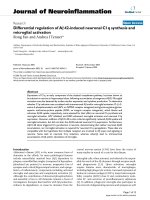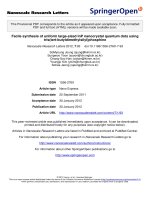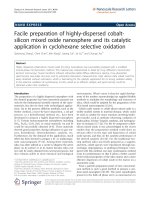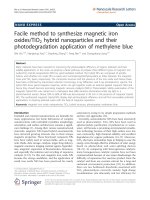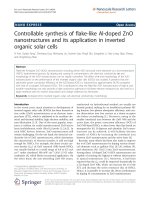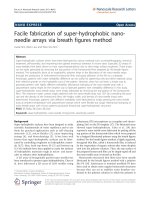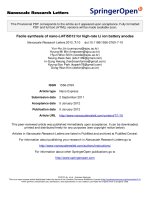Báo cáo hóa học: " Facile Synthesis of Ternary Boron Carbonitride Nanotubes" ppt
Bạn đang xem bản rút gọn của tài liệu. Xem và tải ngay bản đầy đủ của tài liệu tại đây (456.59 KB, 5 trang )
NANO EXPRESS
Facile Synthesis of Ternary Boron Carbonitride Nanotubes
Lijie Luo Æ Libin Mo Æ Zhangfa Tong Æ
Yongjun Chen
Received: 1 March 2009 / Accepted: 14 April 2009 / Published online: 5 May 2009
Ó to the authors 2009
Abstract In this study, a novel and facile approach for
the synthesis of ternary boron carbonitride (B–C–N)
nanotubes was reported. Growth occurred by heating sim-
ple starting materials of boron powder, zinc oxide powder,
and ethanol absolute at 1150 °C under a mixture gas flow
of nitrogen and hydrogen. As substrate, commercial
stainless steel foil with a typical thickness of 0.05 mm
played an additional role of catalyst during the growth of
nanotubes. The nanotubes were characterized by SEM,
TEM, EDX, and EELS. The results indicate that the syn-
thesized B–C–N nanotubes exhibit a bamboo-like mor-
phology and B, C, and N elements are homogeneously
distributed in the nanotubes. A catalyzed vapor–liquid–
solid (VLS) mechanism was proposed for the growth of the
nanotubes.
Keywords B–C–N nanotubes Á Synthesis Á
Stainless steel foil Á Characterization Á VLS model
Introduction
Ternary boron carbonitride (B–C–N) nanotubes have
recently attracted much attention because of their excellent
mechanical properties, electrical properties, and anti-oxi-
dant capacities [1, 2]. In addition, theoretical studies have
revealed that the band gaps of B–C–N nanotubes can be
tailored over a wide range by simply varying the chemical
composition rather than by geometrical structure [3–7],
which is superior to their carbon and boron nitride (BN)
counterparts. This gives B–C–N nanotubes potential for
use in electronics, electrical conductors, high temperature
lubricants, and novel composites [8]. Compared with the
very extensive study about carbon and BN nanotubes,
however, very little work was reported about B–C–N
nanotubes. Since the discovery of B–C–N nanotubes in
1994 [9], several methods have been devoted to the syn-
thesis of B–C–N nanotubes, such as arc-discharge [10],
laser ablation [11], chemical vapor deposition (CVD) [12,
13], template route, and pyrolysis techniques [14, 15].
Particularly, single-walled B–C–N nanotubes have been
recently synthesized by Wang et al. [16] via a bias-assisted
hot-filament method. However, most of them usually used
risky reagents such as diborane (B
2
H
2
)/ammonia (NH
3
), or
produced nanotubes with low purity and high-cost and
encountered the phase separation problem of BN and C.
Thus, it is of great significance to explore novel and
simple routes to prepare B–C–N nanotubes with uniform
distribution of component B, C, and N elements. The
current work reports a relatively safe and effective
approach for growing high-purity B–C–N nanotubes
directly on commercial stainless steel foil, by using simple
raw materials of boron, zinc oxide (ZnO), and ethanol
absolute. The reaction of boron and ZnO at high temper-
ature produces boron oxide vapor that is the source of B,
while ethanol absolute and nitrogen provide the source of
C and N, respectively. It is interesting that the stainless
steel foil is not only the support substrate but also the
catalyst for the growth of the nanotubes. The obtained
nanotubes have an average diameter of about 90 nm and
the B, C, and N elements are found to be homogeneously
distributed in the nanotubes. The growth mechanism of the
nanotubes is also investigated in this study. To the best of
our knowledge, it is the first time to report the synthesis of
L. Luo Á L. Mo Á Z. Tong Á Y. Chen (&)
School of Chemistry and Chemical Engineering,
Guangxi University, Nanning 530004, China
e-mail:
123
Nanoscale Res Lett (2009) 4:834–838
DOI 10.1007/s11671-009-9325-7
ternary B–C–N nanotubes via such a relatively simple
route.
Experimental Methods
The growth of nanotubes was carried out in a conventional
tube furnace. An alumina boat loaded with about 1.0 g
mixture of hexagonal ZnO and amorphous B powder (with
a ZnO:B molar ratio of 1.5:1) was inserted into a quartz
tube and placed at the center of the furnace. Commercial
stainless steel-304 foil with a thickness of 0.05 mm was
inserted into the quartz tube as the substrate. Prior to
heating, the chamber was flushed with high-purity N
2
flow
to eliminate the residual air. Then the furnace was heated to
1150 ° C under a mixture gas flow of N
2
(60 mL min
-1
)
and H
2
(40 mL min
-1
). Ethanol absolute (AR grade) was
introduced into the chamber when the furnace temperature
reached at 1150 °C, which was carried by another N
2
flow
with a rate of 20 mL min
-1
. The furnace was maintained at
1150 ° C for 90 min. Finally, the furnace was cooled nat-
urally to ambient temperature under the protection of N
2
flow. After taken from the furnace, the stainless steel
substrate was found to be covered with white–gray deposit
in the temperature range of 1000–1100 °C. The product
was characterized by field-emission scanning electron
microscopy (FE-SEM, Hitachi S5500), high-resolution
transmission microscopy (HRTEM, JEM-2010F), X-ray
energy dispersive spectrometer (EDS), and electron energy
loss spectroscopy (EELS), respectively.
Results and Discussion
Figure 1 shows the SEM images of the product grown on
the surface of stainless steel substrate. Low-magnification
image (Fig. 1a) indicates a high production of one-
dimensional (1D) nanostructures was synthesized. The
inset in Fig. 1a is a high-magnification cross-sectional
image of some 1D nanostructures, illustrating the hollow
structure of the product. Figure 1b clearly reveals that the
nanotubes are shaped in bamboo consisting of a number of
compartments. The surfaces of the nanotubes are very
clean and no impurities can be observed, which indicates
the high purity of the nanotubes. The diameters of the
nanotubes are approximately 60–120 nm, with an average
value of about 90 nm. Furthermore, it can also be found
that nanoparticles are attached at the ends of nanotubes,
which could be regarded as a typical symbol of vapor–
liquid–solid (VLS) growth model. Figure 1c and d are the
secondary electron and back scattering electron (BSE)
images of the same area of the product. It can be seen that
the attached particles (bright particles) are distinguished
clearly in the BSE image, which further confirms the VLS
growth mechanism of the nanotubes.
The TEM images of the product are shown in Fig. 2.
Similar to SEM observation, the bamboo structure of the
nanotubes with clean surface and uniform diameter along
the nanotube length can be clearly seen (Fig. 2a). The inset
in Fig. 2a is the EDX result, which shows the dominating
peaks of B, C, and N with a low level of O, Cu, and Si. The
existence of Cu peak should be caused by the copper TEM
Fig. 1 a Low-magnification
SEM image of the product,
showing the large quantity of
the 1D product grown on the
stainless steel substrate. The
inset is the high-magnification
cross-sectional image of some
nanotubes, illustrating the
hollow structure. b High-
magnification image of a,
indicating the bamboo-like
structure and high purity of the
nanotubes. c and d The
secondary electron and back
scattering electronic (BSE)
SEM images of the same area of
the product
Nanoscale Res Lett (2009) 4:834–838 835
123
grid, while the Si peak might come from the stainless steel
substrate. The O peak can be ascribed to the slight surface
oxidation of the nanotube. Furthermore, quantitative anal-
ysis gives the B:C:N atomic ratio of about 0.45:0.31:0.24.
Therefore, it can be roughly concluded that the synthesized
nanotubes are B–C–N nanotubes. In Figure 2b, a particle
attached at the end of the nanotube is clearly seen, which is
also consistent with SEM observation. The EDX spectrum
indicates that the particle is mainly composed of Fe with a
small amount of Ni, Cr, Cu, and C (inset in Fig. 2b). As
mentioned above, the Cu and C peaks should come from
the carbon film-coated copper grid. While the existence of
Fe, Ni, and Cr in the particle should originate from the
stainless steel substrate. Hence, we believe that the stain-
less steel substrate play a catalyst role during the VLS
growth of the nanotubes.
Figure 3a shows the HRTEM image of the edge part of
the nanotube wall. It can be seen that the lattice fringes are
Fig. 2 a TEM image of a
nanotube. The inset is the EDX
spectrum of the nanotube.
b TEM image shows a catalyst
particle attached at the end of a
nanotube. The inset is the EDX
spectrum of the particle
Fig. 3 a HRTEM image of
nanotube wall and the
corresponding FFT ED pattern
(inset). b HRTEM image of a
joint between the wall and
compartment and the
corresponding FFT ED pattern
(inset). c and d EELS spectra
taken from the nanotube wall
and the compartment,
respectively, revealing the
dominating composition of B,
C, and N elements in the wall
and compartment
836 Nanoscale Res Lett (2009) 4:834–838
123
well-defined, which suggests that the nanotube wall has a
high degree of crystalline perfection. The interlayer spac-
ing is approximately 0.348 nm, corresponding to the (002)
plane of hexagonal system of B–C–N crystal (JCPDS No.
35-1292). The spots in the fast Fourier-transformed ED
(FFT ED) pattern can be indexed as the (002) basal planes
of the B–C–N layers (inset in Fig. 3a). Figure 3b is the
HRTEM image of the joint, showing the tight connection
between nanotube wall and compartment. The compart-
ment is also well-crystallized with the identical lattice
spacing of about 0.343 nm, which also corresponds to the
(002) plane of B–C–N crystal. The FFT ED pattern (inset
in Fig. 3b) is also indexed as the (002) planes of B–C–N
crystal. Figure 3c shows a representative EELS spectrum
taken from a segment of the nanotube wall, which dem-
onstrates that the distinct absorption peaks of B, C, and N
characteristic K-edges at 188, 201, and 401 eV, respec-
tively. The result further proves the nanotube composition
of B–C–N. The K-edge signals show a discernible p* peak,
as well as an r* band, indicating that the B, C, and N atoms
are in the sp
2
-hybridized state. The EELS spectrum of the
compartment shown in Fig. 3d also indicates the distinct
absorption features of K-edges of B, C, and N atoms.
Furthermore, the elemental maps reveal that B, C, and N
elements are homogeneously distributed in the nanotube
(Fig. 4). Therefore, it can be concluded that the product is
composed of ternary compound B–C–N nanotubes.
As described above, a simple approach to synthesize
B–C–N nanotubes was proposed by involving an additional
role of catalyst of the stainless steel substrate. And based
on the above results, VLS model is believed to be
responsible for the growth of the current nanotubes. Similar
to the literatures reported about BN nanotubes and nano-
wires [17–19], Fig. 5 illustrates schematically the sug-
gested growth process of the B–C–N nanotubes. Firstly, the
reaction of B and ZnO generates Zn and boron oxide
(B
2
O
2
) vapor at high temperature (1150 °C). Meanwhile,
the surface of the stainless steel may partially melt at this
temperature assisted by the erosion of N
2
and H
2
. And thus
liquid alloy droplets with main composition of Fe–Cr–Ni
are formed on the surface, as are verified by the EDX
result. Then the liquid droplets adsorb the growth species
from the surrounding vapors of B
2
O
2
,C
2
H
5
OH, N
2
, and H
2
(Fig. 5a). The involving species of B and C could lead to
the further decrease of the melting temperature of stainless
steel and promotes the formation of liquid droplets. The
reactions among these vapors produce B/C/N atoms, which
diffuse through Fe–Cr–Ni alloy droplets. When the con-
centrations of species are greater than the saturation
threshold, B–C–N crystals begin to precipitate and initially
form the cap on the liquid droplets, as is shown in Fig. 5b.
With the continuous supply of B/C/N atoms, the cap will
be lift from the droplet due to the stress under the curvature
and then the hollow tip forms. At the same time, due to the
diffusion of B/C/N atoms through the surface and bulk, the
B–C–N sheets also grow and form the nanotube wall.
When the nanotube wall grows, the B/C/N atoms also
precipitate inside the nanotube and result in the formation
of compartment layer. The compartment layers connect
with the wall and grow together for a period, and finally
depart from the droplet due to the stress accumulated under
the curved compartment layers (Fig. 5c). As the joint
between compartment and wall forms periodically, the
bamboo-like structure is formed (Fig. 5d). Moreover, the
flowing character of B
2
O
2
,C
2
H
5
OH, N
2
, and H
2
vapors
could lower their partial pressures in the chamber, which is
also favorable for the formation of 1D nanotubes. It should
be noted that the produced Zn vapor is transported by the
carrier gas to a much lower temperature zone (below the
melting point of Zn), where it deposits on the substrate in
the form of Zn products [20]. Therefore, the synthesized
B–C–N nanotubes are not contaminated by Zn products. In
addition, it is found that the hydrogen in the mixture gas is
Fig. 5 The schematic diagram of the B–C–N nanotube growth on the
stainless steel substrate
Fig. 4 Elemental maps of a
nanotube, implying the uniform
distribution of the B, C, and N
species in the nanotube
Nanoscale Res Lett (2009) 4:834–838 837
123
essential for the growth of B–C–N nanotubes. If only pure
N
2
flow is introduced, no B–C–N nanotubes can be
obtained, adding weight to the proposed mechanism and
suggesting that hydrogen plays an important role during the
growth of the B–C–N nanotubes.
Conclusion
In summary, a simple but efficient route to synthesize
B–C–N nanotubes directly onto commercial stainless steel
foil is demonstrated by using raw materials of boron
powder, zinc oxide powder, and ethanol absolute. The
nanotubes are pure with bamboo-like morphology and an
average diameter of about 90 nm. During the formation
process, the stainless steel foil plays a catalyst role addi-
tionally besides the substrate role for the B–C–N nanotube
growth. A VLS process is proposed to be responsible for
the growth of the B–C–N nanotubes.
Acknowledgments The authors acknowledge financial support
from the National Natural Science Foundation of China (NSFC, Grant
No. 50862001), Ministry of Education of China (MOE, Grant No.
208106), Tsinghua University State Key Laboratory of New Ceramics
& Fine Processing and Guangxi University (Grant No. DD040042).
References
1. A.Y. Liu, R.M. Wentzcovitch, M.L. Cohen, Phys. Rev. B 39,
1760 (1989). doi:10.1103/PhysRevB.39.1760
2. P. Dorozhkin, D. Golberg, Y. Bando, Z.C. Dong, Appl. Phys.
Lett. 81, 1083 (2002). doi:10.1063/1.1497194
3. S.Y. Kim, J. Park, H.C. Choi, J.P. Ahn, J.Q. Hou, H.S. Kang,
J. Am. Chem. Soc. 129, 1705 (2007). doi:10.1021/ja067592r
4. L. Liao, K.H. Liu, W.L. Wang, X.D. Bai, E.G. Wang, Y.L. Liu,
J.C. Li, C. Liu, J. Am. Chem. Soc. 129, 9562 (2007). doi:10.1021/
ja072861e
5. Y. Miyamoto, A. Rubio, M.L. Cohen, S.G. Louie, Phys. Rev. B
50, 4976 (1994). doi:10.1103/PhysRevB.50.4976
6. A.M. Enyashin, Y.N. Makurin, A.L. Ivanovskii, Carbon 42, 2081
(2004). doi:10.1016/j.carbon.2004.04.014
7. X. Blase, J.C. Charlier, A.D. Vita, R. Car, Appl. Phys. Lett. 70,
197 (1997). doi:10.1063/1.118354
8. M. Kawaguchi, Adv. Mater. 9, 8 (1997). doi:10.1002/adma.
19970090805
9. O. Stephan, P.M. Ajayan, C. Colliex, P. Redlich, J.M. Lambert,
P. Bernier, P. Lefin, Science 266, 1683 (1994). doi:10.1126/science.
266.5191.1683
10. K. Suenaga, C. Colliex, N. Demoncy, A. Loiseau, H. Pascard, F.
Willaime, Science 278, 653 (1997). doi:10.1126/science.278.
5338.653
11. P. Redlich, J. Loeffler, P.M. Ajayan, J. Bill, F. Aldinger,
M. Ru
¨
hle, Chem. Phys. Lett. 260, 465 (1996). doi:10.1016/0009-
2614(96)00817-2
12. X.D. Bai, J.D. Guo, J. Yu, E.G. Wang, J. Yuan, W.Z. Zhou, Appl.
Phys. Lett. 76, 2624 (2000). doi:10.1063/1.126429
13. L.W. Yin, Y. Bando, D. Golberg, A. Gloter, M.S. Li, X. Yuan,
T. Sekiguchi, J. Am. Chem. Soc. 127, 16354 (2005). doi:10.1021/
ja054887g
14. M. Terrones, D. Golberg, N. Grobert, T. Seeger, M. Reyes-Reyes,
M. Mayne, R. Kamalakaran, P. Dorozhkin, Z.C. Dong, H. Terrones,
M. Ru
¨
hle, Y. Bando, Adv. Mater. 15, 1899 (2003). doi:10.1002/
adma.200305473
15. S. Rahul, B.C. Satishkumar, A. Govindaraj, K.R. Harikumar,
R. Gargi, J.P. Zhang, A.K. Cheetham, C.N.R. Rao, Chem. Phys.
Lett. 287, 671 (1998). doi:10.1016/S0009-2614(98)00220-6
16. W.L. Wang, X.D. Bai, K.H. Liu, Z. Xu, D. Golberg, Y. Bando,
E.G. Wang, J. Am. Chem. Soc. 128, 6530 (2006). doi:10.1021/
ja0606733
17. C.C. Tang, Y. Bando, T. Sato, K. Kurashima, Chem. Commun.
(Camb) 12, 1290 (2002). doi:10.1039/b202177c
18. N. Kio, T. Oku, M. Inoue, K. Suganuma, J. Mater. Sci. 43, 2955
(2008). doi:
10.1007/s10853-007-1750-3
19. Y.J. Chen, B. Chi, D.C. Mahon, Y. Chen, Nanotechnology 17,
2942 (2006). doi:10.1088/0957-4484/17/12/020
20. Y.J. Chen, B. Chi, H.Z. Zhang, H. Chen, Y. Chen, Mater. Lett.
61, 144 (2007). doi:10.1016/j.matlet.2006.04.044
838 Nanoscale Res Lett (2009) 4:834–838
123
